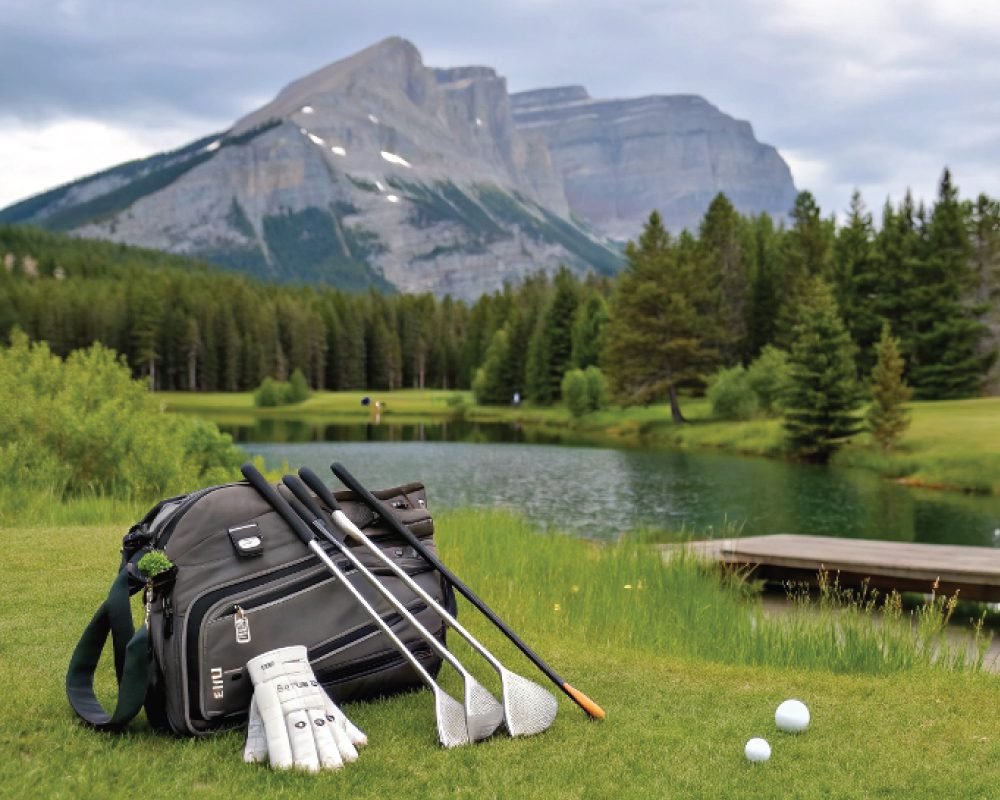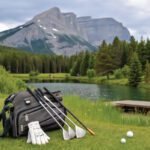
Table of Contents
Discover everything you need to know about golfing in Banff National Park, from iconic courses and local wildlife to insider tips, travel logistics, and seasonal experiences in this complete guide.
Why Golfing in Banff National Park is a Must-Do Experience
A World-Renowned Setting for Golf
Golfing in Banff National Park is unlike any other golf experience in the world. Nestled within the Canadian Rockies, the courses are framed by towering peaks, pristine lakes, and untouched wilderness. This visual backdrop offers a surreal blend of sport and scenery.
A Unique Combination of Nature and Sport
While other courses may boast challenging terrain or elite design, Banff adds a sense of peace and grandeur that few can match. The sound of elk bugling or the sight of a bald eagle soaring overhead during your swing adds an unforgettable dimension to your game.
Home to Canada’s Most Photographed Golf Course
The Fairmont Banff Springs Golf Course is one of the most iconic in the country, often featured in golf magazines and travel brochures. Playing here is as much about the story as the scorecard.
To better understand what makes this location so special, let’s dive deeper into the details of Banff’s premier golf courses.
Top Golf Courses in Banff National Park
Fairmont Banff Springs Golf Course
Located adjacent to the historic Fairmont Banff Springs Hotel, this Stanley Thompson-designed course is a masterpiece. The 18-hole championship course and the 9-hole Tunnel Mountain course both offer rich, scenic views. Watch out for the Devil’s Cauldron hole — a par-3 that plays over a glacial lake.
Canmore Golf & Curling Club
While technically just outside the official park boundary, this course offers a similar mountain golf experience with slightly fewer crowds. It’s a great choice for a relaxed round with stunning alpine views.
Silvertip Golf Course
Located in nearby Canmore as well, Silvertip is perched high above the Bow Valley. The elevation changes make for some thrilling tee shots and strategic play, particularly on the back nine.
Knowing the courses is one thing, but preparing for a successful round in Banff requires a bit more insight.
Best Time for Golfing in Banff National Park
Late Spring to Early Fall is Ideal
Golfing in Banff National Park typically runs from mid-May through early October. June, July, and August offer the most consistent weather and longest daylight hours.
Shoulder Seasons Offer Lower Prices
May and October can be hit-or-miss due to unpredictable weather, but they come with lower green fees and fewer tourists. Be prepared for potential frost delays in the morning.
Morning vs Afternoon Tee Times
Early mornings often offer calm winds and more wildlife sightings, while afternoon tee times provide warmer temperatures and softer light for photography.
Weather is just one factor; understanding the terrain and how to approach these unique courses is equally important.

Image by Markus Spiske from Pixabay
Golfing in Banff National Park – Course Attributes
| Attribute | Details |
|---|---|
| Location | Banff, Alberta (within Banff National Park) |
| Holes | 18-hole Championship + 9-hole Tunnel |
| Notable Features | Historic design, Devil’s Cauldron hole |
| Season | Mid-May to Early October |
| Skill Level | All levels (challenging for pros) |
| Rating | 4.8/5 |
| Area | More than 7,000 yards |
Course Conditions and Terrain Challenges in Golfing in Banff National Park
Mountain Terrain Adds Complexity
Elevation changes, thinner air, and undulating fairways all impact your shot strategy. The ball travels farther, but the slopes require careful club selection.
Wildlife Encounters on the Course
Deer, elk, and sometimes even bears may be seen on or near the fairways. These encounters are usually harmless, but golfers must give animals space.
Greens Can Be Tricky
Stanley Thompson’s design includes multi-tiered greens and subtle breaks that challenge even seasoned players. Course management and reading putts become critical.
With the natural environment Golfing in Banff National Park such a strong role, let’s take a moment to look at how Banff incorporates sustainability into its golf culture.
Sustainability and Wildlife Protection
Eco-Friendly Course Management
Golfing in Banff National Park courses prioritize eco-friendly practices. Water conservation, organic fertilizers, and integrated pest management all play a role in maintaining the land.
Respecting Wildlife Corridors
Golfers are urged to avoid disturbing animals and to use designated paths. Courses are designed to minimally impact the native habitat, allowing wildlife to coexist with sport.
Leave No Trace Principles
Whether you’re hiking between holes or enjoying the view, be sure to pack out your trash and avoid damaging flora or fauna.
Once you’ve decided to experience this amazing destination, how should you plan your trip?
Planning Your Golf Trip to Banff
Where to Stay
From the luxurious Fairmont Banff Springs Hotel to cozy lodges and budget motels in nearby Canmore, you’ll find accommodation options for every traveler.
Getting to Banff
Most visitors fly into Calgary International Airport and drive 1.5 hours west to Banff. Shuttle services and rental cars are available year-round.
Golf Packages and Deals
Many resorts and hotels offer stay-and-play packages, especially in the shoulder seasons. These bundles can include tee times, accommodations, and dining credits.
A well-planned trip makes a huge difference, but don’t forget to pack the right gear for the conditions.

What to Pack for Golfing in Banff
Clothing for All Weather
Mountain weather changes quickly. Bring waterproof outerwear, layers, and a hat. Mornings can be chilly even in July, while afternoons may feel hot.
Course-Appropriate Footwear
Spikeless golf shoes with strong grip are ideal for Banff’s terrain. Be prepared for wet grass, elevation, and uneven lies.
Tech and Accessories
A rangefinder is useful on mountainous courses with limited visibility. Also bring polarized sunglasses, sunscreen, and a reusable water bottle.
With your bags packed and your itinerary set, it’s time to look at some additional tips that can elevate your experience.
Insider Tips for the Best Golf Experience
Book Early
Tee times fill quickly in peak season. Book months in advance, especially for Fairmont Banff Springs.
Warm Up Properly
Allow time for stretching and short game practice. The altitude can affect your stamina if you’re not prepared.
Take Your Time
Savor the experience. This is not just golf—it’s a memory you’ll talk about for years. Pause to take photos and appreciate the views.
Even with all this excitement, it’s helpful to know what not to do when golfing in Banff.
Common Mistakes to Avoid
Underestimating the Altitude
Your ball will fly farther, but your body may tire quicker. Hydrate well and don’t overexert yourself early in the round.
Ignoring Course Etiquette Around Wildlife
Approaching or feeding wildlife is strictly prohibited. Maintain distance, and if an animal is on the green, wait or move on.
Forgetting to Check Weather Forecasts
Mountain weather can turn quickly. Always check forecasts and pack extra gear to avoid uncomfortable or unsafe conditions.
You’re almost ready to hit the greens—let’s answer some final questions that many first-timers have.
Conclusion
Golfing in Banff National Park isn’t just about playing 18 holes — it’s about embracing the full experience of mountain sport, wilderness, and luxury. The majestic surroundings, iconic courses, and attention to conservation create a destination that blends nature and sport seamlessly. Whether you’re a seasoned golfer or someone looking to check a bucket-list course off your list, Banff delivers an unforgettable golfing journey. With the right preparation and respect for the land, you’ll walk away with not only a scorecard but also lasting memories.
Also read our recent blog – Best Portable Gazebo for Camping and Park Adventures
Is it expensive to golf in Banff National Park?

Prices vary by season. In peak summer months, expect to pay premium rates—especially at Fairmont Banff Springs. Deals are available in spring and fall.
Can beginners golf in Banff?
Absolutely. While the terrain can be challenging, there are tee placements and courses suitable for all skill levels.
Do I need to book tee times in advance?
Yes. Especially during summer, it’s highly recommended to book well in advance. Last-minute walk-ons are rare.
What wildlife might I see while golfing?
Elk, deer, bighorn sheep, and even bears have been seen on the courses. Always keep a safe distance and alert course staff if needed.
Can I rent golf clubs in Banff?
Yes. Most courses, especially Fairmont Banff Springs, offer high-quality rental sets, including left-handed and women’s options.
Are golf carts mandatory?
Carts are available but not mandatory. However, walking can be strenuous at high elevations, so carts are recommended for those not acclimated.
What should I wear?

Proper golf attire is expected. Bring layers to adjust for weather and waterproof shoes for dewy mornings or rainy conditions.

Badhan is a passionate blogger, content writer, SEO expert, and graphic designer who helps brands grow through strategic content and creative design.